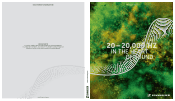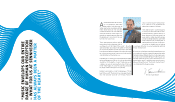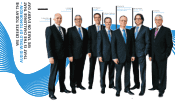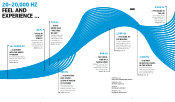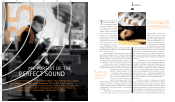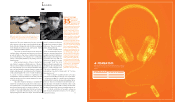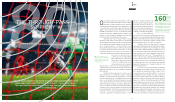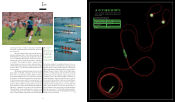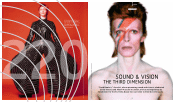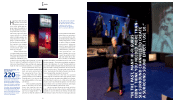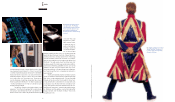Sennheiser 2012 Annual Report Download - page 7
Download and view the complete annual report
Please find page 7 of the 2012 Sennheiser annual report below. You can navigate through the pages in the report by either clicking on the pages listed below, or by using the keyword search tool below to find specific information within the annual report.
13
XX Hz 80 Hz
On a June day in 1986, the very foundations of Mexico
City’s Aztec Stadium were shaken. An extraordinary
atmosphere, an almost religious ecstasy – like those
many people feel as they are exposed to a great piece of art
– was felt by the some 114,600 viewers seated under the
gigantic dome. Argentina’s Diego Maradona had single-
handedly brought the score up to 2:0, pushing 50 meters
past the opposing team – dribbling past his competitors like
ninepins – to drive the ball into England’s goal. Years later,
his athletic feat was voted the goal of the century.
Argentine radio reporter Hugo Morales followed
Maradona’s magic march from the press box. He immedi-
ately knew that he would never be able to keep up with the
all-out attack by reporting in complete words, let alone sen-
tences. “Siempre Maradona ...,” is all he could get out and
these syllables have become almost as famous as the goal of
the century: “Genio! Genio! Genio! Ta! Ta! Ta! Goooooool!” By
translating Maradona’s fast twists into short blasts of
sound, without realizing it, Morales was anticipating sports
sonification, a method sports re-
searchers such as Prof. Alfred Effen-
berg of the University of Hanover are
using today to capture the sequence
of motions of swimmers and rowers.
Using synthesizers and computers,
they are able to construct an “acoustical fingerprint,” a
soundtrack of the motion. By employing this acoustical tool
during training, athletes can correct mistakes and improve
their technique.
Effenberg’s latest experiment is sound soccer, in
which the professor is conducting a study to establish
whether or not ear training is also applicable to soccer. The
Borussia Dortmund fan, who – despite having the same last
name – is not related to the former FC Bayern star, sought
out a competent partner. Cologne musicologist Manfred
Müller had already translated soccer players’ dribblings into
music for a radio show during the 2010 FIFA World Cup in
South Africa. Film composer Matthias Hornschuh assisted
him in translating the “Ta! Ta! Ta!” into beats and notes, turn-
ing sound soccer into a truly interdisciplinary project. “Good
teamwork is dependent on the players having a common
time base,” explains Effenberg. “We
know that synchronizing the timing of
more than one person is better con-
trolled using acoustical than visual sig-
nals, so we looked into whether a cer-
tain type of music and certain rhythm
could improve a team’s passing game.”
It’s no coincidence then that
football reporters transcribe football teams into music.
Dynamic soccer teams like Real Madrid and Dynamo Kyiv are
known as white ballet and red orchestra. Using tiki-taka to
describe the short quick passing game of the World and
European Champion Spain is also pure onomatopoeia.
Effenberg and his staff have three soccer teams
participating in their experiment. Not Real Madrid or FC Bay-
ern, but the youth and men’s team of FV Engers 07, and the
women’s team of Eintracht Wetzlar, both German associa-
tion football clubs. Sennheiser provided the technology. Prof.
Jürgen Peissig from the research department was immedi-
ately enthralled by sound soccer: “If the experiment suc-
ceeds, it could open up a completely new market,” and sees
a real potential for innovation. The project requires high
standards of quality because “ultimately, the complete mu-
sical spectrum from 20 to 20,000 Hz has to be transmitted
wirelessly to the players’ ears – the perfect situation for our
in-ear monitor systems.”
In sound soccer, directional antennas are installed
on the sidelines and each player wears a Sennheiser in-ear
sports headphone designed especially for joggers. Its sili-
cone earclips ensure a secure fit. In addition to soccer shoes
and shin guards, each test subject also wears a receiver on
his or her body. The mobile-phone-sized EK 300 IEM G3 is
attached to a belt around the hips. The trainers caution the
players not to battle too hard. Effenberg and his staff then
give the athletes instructions, but none of them know what
it is all about nor whether the other players are also listen-
ing to music. Five teams are randomly picked. At first, they
play against each other without listening to music, and then
with music. Müller and Hornschuh’s composition is a sonifi-
cation of the dribbling of South African national player Teko
Modise set to the rhythm of 140 bpm. Ball and ground con-
German sound engineers are on the trail of a winner’s rhythm. Their sound
soccer experiment shows that music can improve a soccer team’s game.
The right acoustical input drives a faster one-two pass – from the dance
floor to the winning goal.
SOUND SOCCER
e1. Cross, header, boom!
Bayern München striker Mario
Gómez shows how to set up
the perfect attack. Here, in
front of the goal.
BEATS PER MINUTE
160That’s the
minimum
beats per
minute
(bpm) of a drum or bass track – and
the beat of Maradona-successor Lio-
nel Messi’s dribble. Whereas rowing
eights might find 40 bpm too fast,
in classical music it’s considered
slow (lento). Sound soccer research-
ers play 140 bpm in players’ ears –
and improve their passing games.
12
THE THROUGH-PASS
SYMPHONY
80

